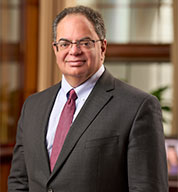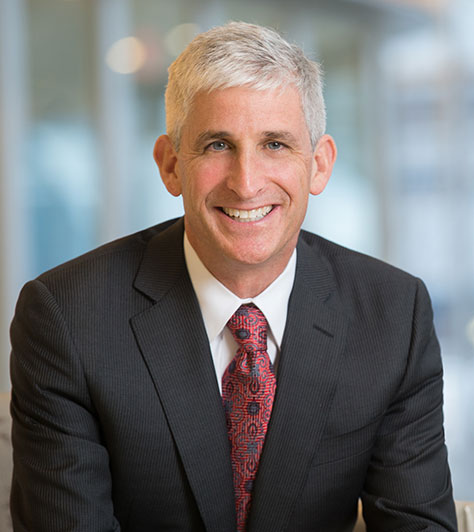COVID-19 Spurs Innovation at University Hospitals in Cleveland, Ohio
June 29, 2020
Positive, even life-saving, results will long outlive the novel coronavirus
UH Innovations COVID-19 Special Issue | Summer 2020
 Cliff Megerian, MD
Cliff Megerian, MD Dan Simon, MD
Dan Simon, MD
A national crisis in healthcare requires embracing innovations, creating workarounds, and allowing little time for bureaucratic slowdowns. Caution and safety standards remain in use, but intense pressure creates a laser focus that brings solutions and advances that would have taken far longer under typical circumstances.
This is what occurred at University Hospitals from the time COVID-19 first presented in Northeast Ohio in early March. Cliff Megerian, MD, President, University Hospitals, and Dan Simon, MD, Chief Clinical & Scientific Officer and President, UH Cleveland Medical Center, here describe some of the innovations that brought positive, even life-saving results, and will long outlive the COVID-19 virus.
These discoveries will continue to serve many UH patients and the system as a whole – as well as the patients of other healthcare systems around the country.
UH’s crucial first act was to create a 24/7 Unified Hospital Incident Command Center, where representatives and decision makers from all parts of the system were housed in one room. This model is one used for planned and unplanned emergency management activities (such as natural disasters and pandemics), for improving planning, response and recovery. The environment is fast-paced, decisions must be made without all the data readily available, and everyone must be flexible to change plans on a moment’s notice. Most importantly, such a team breaks down the silos that occur naturally in any organization – thus allowing for a rapid response. Once a healthcare system knows that beneficial changes can be made more rapidly than we are accustomed to, it’s harder to accept methods that may needlessly slow down innovations.
While there were quick responses in the areas of testing and research (many of these are detailed in other articles in this issue of Innovations), we made other logistical changes from which we continue to benefit.
One was the rapid shift to telehealth visits, which rose from about 1 percent of system visits in early March to 50 percent by the end of April. That translates to about 100,000 “virtual” visits in two months. This could not have happened without our IT department quickly creating additional portals to patients. While we previously relied on the MDLive platform for telehealth visits, we soon learned that many patients were more familiar with other platforms, such as FaceTime, Zoom and Skype. So our technology team quickly added five additional portals on which patients could connect with caregivers. We will continue to use these additional methods, because that’s what patients prefer.
“Patients previously seemed hesitant to make telehealth visits, until the pandemic essentially made it the best option for most,” says Dr. Megerian. “Their having started to do so under pressure has led to a comfort level that patients and caregivers now have in using these methods. That ensures they will remain an important and growing option for future patient visits.”
Another innovation showed how our medical innovators often go above and beyond a standard response. Since the late 1990s, Dr. Raymond Onders, now the UH Chief of General and Gastrointestinal Surgery, experimented with using electrical stimulation to pace and drive the diaphragm and help ventilation and breathing. Then the technology began to be successfully used in patients with chronic ventilation issues, including those with quadriplegia and ALS. More recently, Dr. Onders improved care for patients who must be on a ventilator, at least temporarily – such as those who have open-heart surgery. He and Dr. Alan Markowitz, UH Chief Surgical Officer Co-Director, Valve & Structural Heart Disease Center, realized that as the incision from the surgery is being closed, it was fairly simple to place temporary pacing wires on the diaphragms of these patients.
“During the COVID-19 threat, Dr. Onders determined that this approach could reduce ventilator burden in COVID-19 patients or other patients in our intensive care units by 26 percent,” says Dr. Megerian. “This would help free up more ventilators in a time of great demand. We also found that there were actually better outcomes in patients who needed respiratory support but did not have to be intubated. “
In addition to this temporary diaphragm pacing having been used in COVID patients in our system, it also was used in a Detroit hospital during the COVID crisis, with the guidance of Dr. Onders during the patients’ prolonged recovery process.
Dr. Simon points to another innovation that addressed ventilator use – the SafetyNet monitor from Masimo, which was brought to our attention by Peter Pronovost, MD, PhD, the UH Chief Clinical Transformation Officer. The monitor allows us to keep people healthier or healing at home rather than in the hospital. It’s a disposable device that monitors oxygen saturation, blood pressure, heart rate and respiratory rate and sends a signal through a patient's cellphone at home to a hospital's command center. “This is crucial for the care of COVID-19 patients with viral pneumonia. We can avoid admission safely by monitoring oxygen saturation continuously or reduce length of stay by discharging patients when they are on the road to recovery, but still require daily monitoring,” says Dr. Simon. “It will be important post-COVID for other patients, especially those with heart failure and chronic obstructive pulmonary disease.”
Another device that aided our efforts for COVID-19 patients was a pneumatic resuscitator, a simplified version of the ventilators that we and other hospitals were using for patients with COVID-19. The device received fast track approval from the FDA so that it could get on the market quickly. Cleveland businessman Dan Moore owned the company which manufactured the device in Cleveland; he worked with UH Chair of Urology Dr. Lee Ponsky and UH anesthesiologist Dr. Mada Helou, who helped engineers refine the design. This inexpensive ventilator went from prototype to production in a little over three weeks – and 500 could be produced each week.
Finally, there are sometimes silver linings which can occur from an adaptation to forced change, and Dr. Simon points to one. “The initiation of a no-visitor policy was to protect visitors from getting COVID-19, as well as to protect patients from visitors and preserve PPE,” he says. “While this was often distressing to patients and their family members who could not offer support or comfort in person at the bedside, caregivers adapted by scheduling daily communication with patients and families to efficiently and compassionately discuss care plans.”
We were initially concerned that patient experience evaluations might deteriorate during the COVID pandemic. Surprisingly, our patient experience scores are higher than ever at UH Cleveland Medical Center. Patient experience domains related to communication with nurses and doctors and transitions in care (e.g., discharge medications and follow-up appointments) improved in April and May during the height of our COVID admissions.


